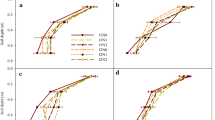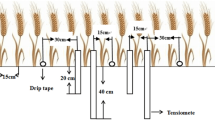Summary
The objective of this study was to evaluate the distribution of cotton (Gossypium hirsutum cv GSA 71) root system under four depths of trickle irrigation emitter. Cotton was grown on an Amarillo fine sandy loam (fine loamy, mixed thermic Aridic Paleustalf) at Lubbock, Texas. Trickle irrigation was applied at the surface (0), 0.15, 0.3, or 0.45 m depths in amounts calculated using daily pan evaporation, crop coefficient, and crop development stage. Effects of depth of trickle irrigation were evaluated by measuring the cotton root-length density in 0.15 m increments to the 0.90 m depth at distances of 0, 0.25, and 0.5 m perpendicular to the cotton rows. The root-length distributions were not significantly (0.05%) different in the top 0.15 m when the surface irrigated treatment was compared with the 0.45 m irrigation depth treatment. Root-length densities for the 0.15 and 0.3 m treatments were not significantly different from one another nor were they different from treatments within the evaluated zones (0 to 0.3 m or 0.15 to 0.45 m). Root-length density within the 0.3 to 0.6 m zone, was not significantly different for the 0.45 m treatment compared with the surface irrigation treatment. Root-length density in the 0.6 to 0.9 m zone was not significantly different for any treatment. Emitter depth of trickle irrigation did not significantly influence the depth or distribution of cotton-root development.
Similar content being viewed by others
References
Bruner WE (1932) Root development of cotton, peanuts and tobacco in central Oklahoma. Proc OK Acad Sc 20
Carmi A, Shalhevet J (1983) Root effects of cotton growth and yield. Crop Sci 23:875
Derera NF, Marshall DR, Balaam LN (1969) Genetic variability in root development in relation to drought tolerant spring wheats. Exp Ag 5:327
Doorenbos J, Pruitt WO (1977) Guidelines for predicting crop water requirements. FAO Irrig and Drain Paper no 24
Fereres ER, Cuevas R, Orgaz F (1985) Drip irrigation of cotton in Southern Spain. In: Third Intern Drip Trickle Irrig Cong. Fresno, Ca. Vol I, p 187
Klepper B, Taylor HM, Huck MG, Fiscus EL (1973) Water relations and growth of cotton in drying soil. Agron J 65:307
Long OH (1959) Root studies on some farm crops in Tennessee. Univ TN Bull 301
McMichael BL (1986) Growth of roots. In: Mauney JR, Stewart J (eds) Cotton physiology. Cotton Foundation Memphis TN, p 29
Oron G, Karmeli D (1979) The flow regime in the root zone. Israel J Tech 17:99
Phene CJ, Davis KR, Howell TA, McCormick RL, Nightingale HI (1984) Evapotranspiration and water use efficiency of trickle irrigated cotton. ASAE Winter meeting. New Orleans, LA, paper No 84-2625
Taylor HM, Klepper B (1974) Water relations of cotton. I. Root growth and water use as related to top growth and soil water content. Agron J 66:584
Weaver JE (1926) Root development of field crops. McGraw-Hill, New York
Wilson PH, Ayer H, Snider G (1984) Drip irrigation for cotton: Implications for farm profits. USDA Eco Res Ser, Ag Eco Rep No 517
Author information
Authors and Affiliations
Rights and permissions
About this article
Cite this article
Kamara, L., Zartman, R. & Ramsey, R.H. Cotton-root distribution as a function of trickle irrigation emitter depth. Irrig Sci 12, 141–144 (1991). https://doi.org/10.1007/BF00192285
Received:
Issue Date:
DOI: https://doi.org/10.1007/BF00192285




